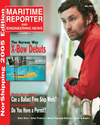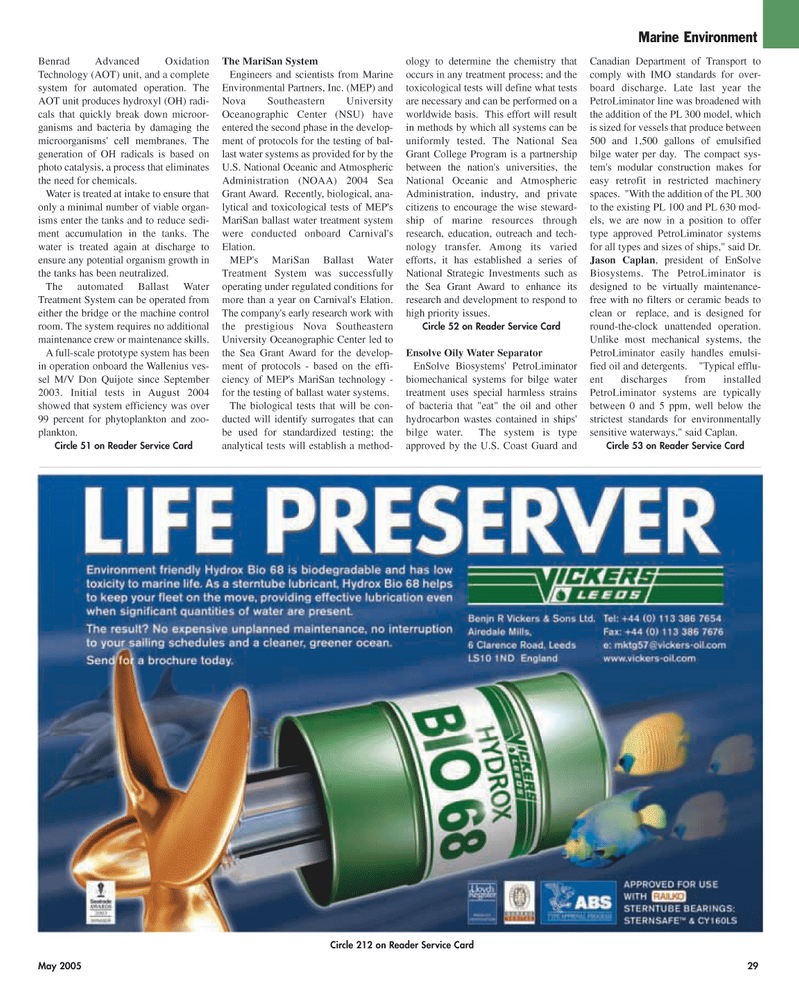
Page 29: of Maritime Reporter Magazine (May 2005)
Marine Enviroment Edition
Read this page in Pdf, Flash or Html5 edition of May 2005 Maritime Reporter Magazine
Circle 212 on Reader Service Card
May 2005 29
Benrad Advanced Oxidation
Technology (AOT) unit, and a complete system for automated operation. The
AOT unit produces hydroxyl (OH) radi- cals that quickly break down microor- ganisms and bacteria by damaging the microorganisms' cell membranes. The generation of OH radicals is based on photo catalysis, a process that eliminates the need for chemicals.
Water is treated at intake to ensure that only a minimal number of viable organ- isms enter the tanks and to reduce sedi- ment accumulation in the tanks. The water is treated again at discharge to ensure any potential organism growth in the tanks has been neutralized.
The automated Ballast Water
Treatment System can be operated from either the bridge or the machine control room. The system requires no additional maintenance crew or maintenance skills.
A full-scale prototype system has been in operation onboard the Wallenius ves- sel M/V Don Quijote since September 2003. Initial tests in August 2004 showed that system efficiency was over 99 percent for phytoplankton and zoo- plankton.
Circle 51 on Reader Service Card
The MariSan System
Engineers and scientists from Marine
Environmental Partners, Inc. (MEP) and
Nova Southeastern University
Oceanographic Center (NSU) have entered the second phase in the develop- ment of protocols for the testing of bal- last water systems as provided for by the
U.S. National Oceanic and Atmospheric
Administration (NOAA) 2004 Sea
Grant Award. Recently, biological, ana- lytical and toxicological tests of MEP's
MariSan ballast water treatment system were conducted onboard Carnival's
Elation.
MEP's MariSan Ballast Water
Treatment System was successfully operating under regulated conditions for more than a year on Carnival's Elation.
The company's early research work with the prestigious Nova Southeastern
University Oceanographic Center led to the Sea Grant Award for the develop- ment of protocols - based on the effi- ciency of MEP's MariSan technology - for the testing of ballast water systems.
The biological tests that will be con- ducted will identify surrogates that can be used for standardized testing; the analytical tests will establish a method- ology to determine the chemistry that occurs in any treatment process; and the toxicological tests will define what tests are necessary and can be performed on a worldwide basis. This effort will result in methods by which all systems can be uniformly tested. The National Sea
Grant College Program is a partnership between the nation's universities, the
National Oceanic and Atmospheric
Administration, industry, and private citizens to encourage the wise steward- ship of marine resources through research, education, outreach and tech- nology transfer. Among its varied efforts, it has established a series of
National Strategic Investments such as the Sea Grant Award to enhance its research and development to respond to high priority issues.
Circle 52 on Reader Service Card
Ensolve Oily Water Separator
EnSolve Biosystems' PetroLiminator biomechanical systems for bilge water treatment uses special harmless strains of bacteria that "eat" the oil and other hydrocarbon wastes contained in ships' bilge water. The system is type approved by the U.S. Coast Guard and
Canadian Department of Transport to comply with IMO standards for over- board discharge. Late last year the
PetroLiminator line was broadened with the addition of the PL 300 model, which is sized for vessels that produce between 500 and 1,500 gallons of emulsified bilge water per day. The compact sys- tem's modular construction makes for easy retrofit in restricted machinery spaces. "With the addition of the PL 300 to the existing PL 100 and PL 630 mod- els, we are now in a position to offer type approved PetroLiminator systems for all types and sizes of ships," said Dr.
Jason Caplan, president of EnSolve
Biosystems. The PetroLiminator is designed to be virtually maintenance- free with no filters or ceramic beads to clean or replace, and is designed for round-the-clock unattended operation.
Unlike most mechanical systems, the
PetroLiminator easily handles emulsi- fied oil and detergents. "Typical efflu- ent discharges from installed
PetroLiminator systems are typically between 0 and 5 ppm, well below the strictest standards for environmentally sensitive waterways," said Caplan.
Circle 53 on Reader Service Card
Marine Environment
MR MAY 2005 #4 (25-32).qxd 5/2/2005 7:03 PM Page 29

 28
28

 30
30
